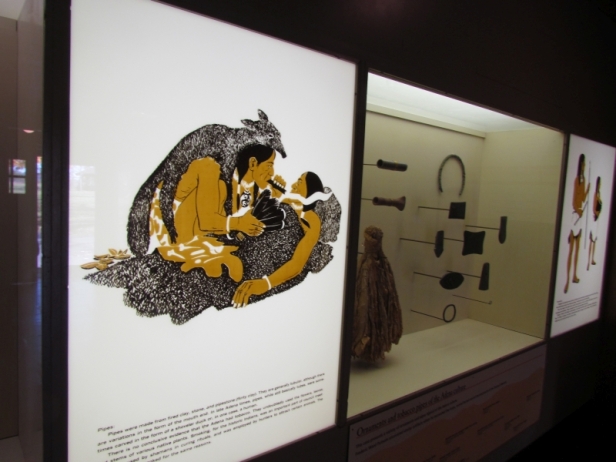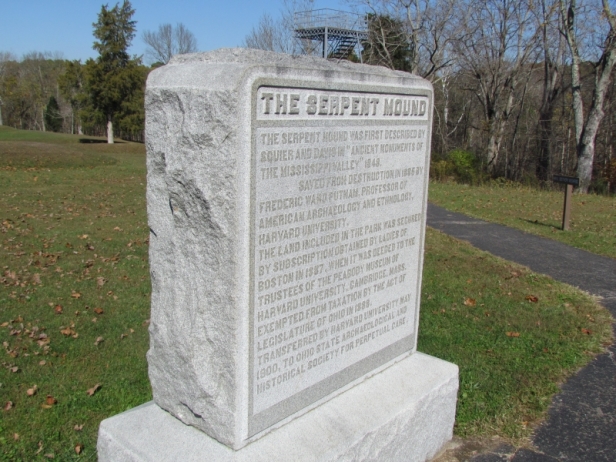Serpent Mound State Memorial
Last weekend the family was on the road again- we were going to a state park, but make a stop at Serpent Mound State Memorial.
Serpent Mound is along State Route 73 in southern Ohio, in a fairly out-of-the-way area. Re-discovered by European settlers as early as 1815, it eventually became the first privately-funded archaeological preserve in the US (by Harvard University) to preserve it from becoming ploughed-under farmland. By 1900. ownership was granted to an early version of the Ohio Historical Society, which runs the site today.
Parkland and a gift shop/museum can be found near the entrance
And then we come to the mound itself- what is the Serpent Mound?

The Serpent Mound itself is over 1,300 feet of earthworks built into the shape of a snake. This is the largest snake mound in the world. It was created centuries ago by the Adena Culture of native Americans. It was for some time thought to be 1,000 years old, but recent dating methods stretch its creation back as far as 2,900 years ago. It may have been renovated 1,000 years ago, indicating that this site has been used for a long time. Fairly modern renovations in the 1880s have helped reconstruct the early appearance of the mound.
Serpent Mound overlooks the bluffs of Brush Creek. The site is unique for another reason:
The mound is located on a plateau with a unique cryptoexplosion structure that contains faulted and folded bedrock, usually produced either by a meteorite or a volcanic explosion. In 2003 geologists from Ohio State government and the University of Glasgow (Scotland) concluded that a meteorite strike was responsible for the formation. They had studied core samples collected at the site in the 1970s. Further analyses of the rock core samples indicated the meteorite impact occurred during the Permian Period, about 248 to 286 million years ago.
This is one of the few places in North America where such an occurrence is seen. While some scholars speculate that prehistoric Native Americans may have placed the mound in relation to this geological anomaly, others think there was nothing visible at ground level that would have captured their attention.
What is the significance of the serpent?
Late Woodland Period graves at the site suggest the earthwork served a mortuary function, and that this was the principal nature of the site, directing spirits of the dead from burial mounds and subsurface graves northward, not a place to conduct large ceremonial gatherings as has been suggested by tourism/promotion interests.
The curled tail of the serpent
In 1987 Clark and Marjorie Hardman published their finding that the oval-to-head area of the serpent is aligned to the summer solstice sunset. William F. Romain has suggested an array of lunar alignments based on the curves in the effigy’s body. Fletcher and Cameron argued convincingly for the Serpent Mound’s coils being aligned to the two solstice and two equinox events each year. If the Serpent Mound were designed to sight both solar and lunar arrays, it would be significant as the consolidation of astronomical knowledge into a single symbol. The head of the serpent is aligned to the summer solstice sunset and the coils also may point to the winter solstice sunrise and the equinox sunrise.
The Serpent Mound may have been designed in accord with the pattern of stars composing the constellation Draco. The star pattern of the constellation Draco fits with fair precision to the Serpent Mound, with the ancient Pole Star, Thuban (α Draconis), at its geographical center within the first of seven coils from the head. The fact that the body of Serpent Mound follows the pattern of Draco may support various theses.
The body of the serpent
Ancient Native American cultures were building earthworks much like many cultures worldwide were doing at different times in prehistory. A huge amount of work went into these substantial mounds, which certainly helped create a world of meaning in a time before advanced technology. The whole thing is fascinating to think about, and gives you a respect for peoples long gone.























Fabulous shot..
Many thanks, Roger!
Great post about a very fascinating place.
Thanks, Robert! I always enjoy seeing the Indian mounds around central Ohio, this one was amazing!
You guys have the best weekends! Impressive mound and interesting info on the meteorite strike.
I had never heard about the meteorite impact area there before, Inger- always something to learn!
Wonderful post! I have been to many Indian Mounds but was unaware that there were Serpent Mounds. I have added this to my “Must Visit” list.
You’ll enjoy it I’m sure, Holly!
A very interesting post.
Thanks, Tootlepedal! You have so much history around you in the UK I am envious sometimes!
Such a wonderful historical site.
It was awesome being there, Pat!
Not till after I was past elementary school and high school did I learn about the mound builders that flourished in many parts of what is now the United States. Those school days are half a century behind me, and schools may teach about the mound builders now, but I doubt it, based on many other things I know about the American education system. In any case, I’m happy for you that you got to visit this site in Ohio.
It was impressive, Steve- I can’t remember learning much about the Mound Builders in school, either.